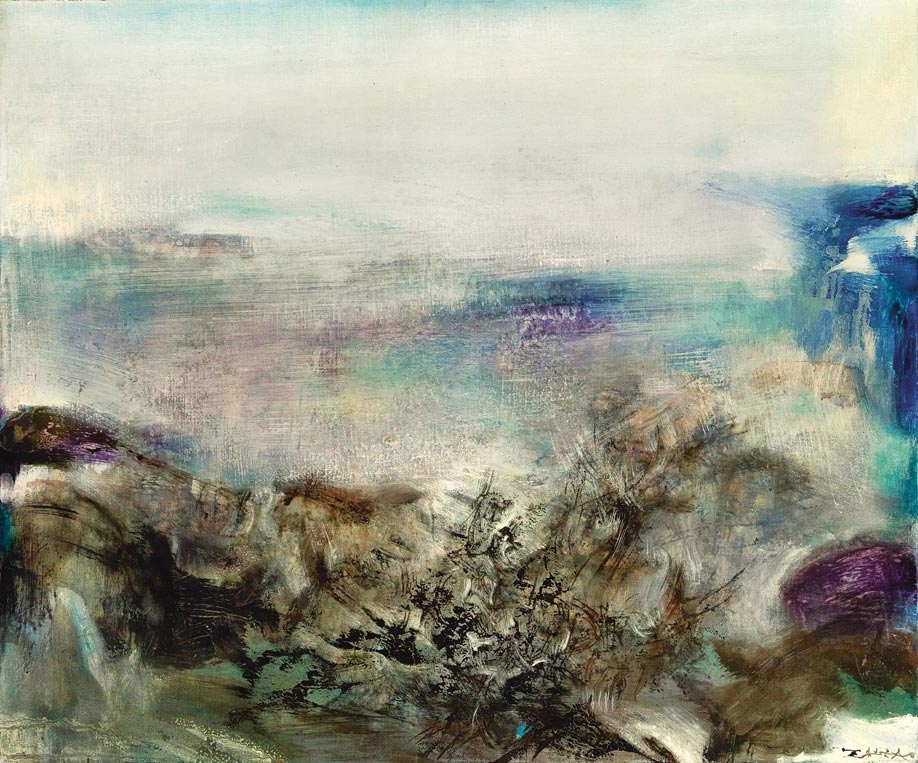When Zao Wou-ki held his first solo exhibition in Paris, art critics have already considered him as a genius painter, later, Zao established his own style and consolidated his position in the international art circle. He is also the senior abstract painter in China. French art critic Marchesseau described Zao's paintings as "the fusion of two unique worlds", Zao as "a Chinese in Paris, a Chinese in China", and praised his blending the essences from both Chinese and western traditions and his breakthrough. Zao made use of painting mediums proficiently, he enlarged his view to the whole universe, arranged the elements with rich imaginations and his talents proficiently, successfully created soulful pieces of works. He used fierce brush strokes and the splash ink techniques to paint the western abstract paintings, his sparks splashed in the art world are as bright as a star, lightened up the eastern and western night skies. Zao Wou-ki loves art with his life, he once said that paintings are "suite sans fin", therefore he will not stop, he will paint until his life ends.
Art critic Jonathan Hay once remarked that Zao Wou-ki's favourite colour is black. One painting in which his use of this colour is indeed impressive is "Hommage to Henri Matisse", which was finished in 1986. Shades of blue, black, yellow and a little bit of red are applied in a manner strongly reminiscent of Chinese ink-and-wash. Black is clearly the crucial colour that holds together this imaginary panorama of the artist's soul, brimming with a mysterious and poetic quality.
In the 1970s, Zao began to experiment with ink-and-wash, which added a lot of variety and depth to the works of his later period. Zao was able to express chromatic variation and uninhibited spatial expansion employing nothing but shades of grey and black. While others were restrained by their strict adherence to only a single tradition, Zao, who was 'at home in two tradition' displayed in his later oeuvre a calm confidence and unbridled creativity that communicates the artist's emotions with a natural ease. "M ême de petit format, les encres de Chine de Zao Wou-ki évoquent la dimension cosmique. Revenantà l'hule, le peinture use, comme irr?istiblement, des formats de plus en plus grands. C'est la un trait caract?istique de cette derniêre periode."(cf. François Cheng, Par-delà l'Est et l l'Quest', Zao Wou-ki, Galerie nationale du Jeu de Paume, Paris, 2003, p. 21) Therefore, when compared to the artist's earlier periods, we find a lot more large-scale or triptych paintings, also distinguished by their more brisk and sanguine use of colour, in his recent works.
In "25.11.71" Zao Wou-ki employs the so-called cunfa (a Chinese painting technique for representing irregular surfaces, most frequently used to show the shades and texture of rocks and mountains in landscape painting by light ink strokes). His use of the method proves to be highly effective in expressing the vast expanses of unlimited visionary vistas, like the touching beauty of a fertile plain, or the tranquility of a silent night. The refined light yellow of a gosling's feather and a pastel shade of violet embrace the mysterious, sophisticated mood of the painting, redolent of delicate wisps of light clouds announcing the arrival of spring, or the gentle caress of a soft breeze. In the catalogue of Zao's solo exhibition in New York in 2003, Jonathan Hay wrote: "Contrastingly, several other works favor understatement, with muted harmonies that are sometimes pointed up by a touch of more intense color.... Here the surfaces tend to be less worked and there is a particular lightness of touch. Between these two poles are situated all manner of hybrids in which Zao searches for an equilibrium between a saturated hue-a vermilion, an acid yellow-and more muted harmonies of color built around black/grey/brown/white brush traces that hint at an image." (cf. Jonathan Hay, 'Zao Wou-ki, Lately' Zao Wou-ki Recent Works, Marlborough Gallery, New York, 2003, p. 7)
